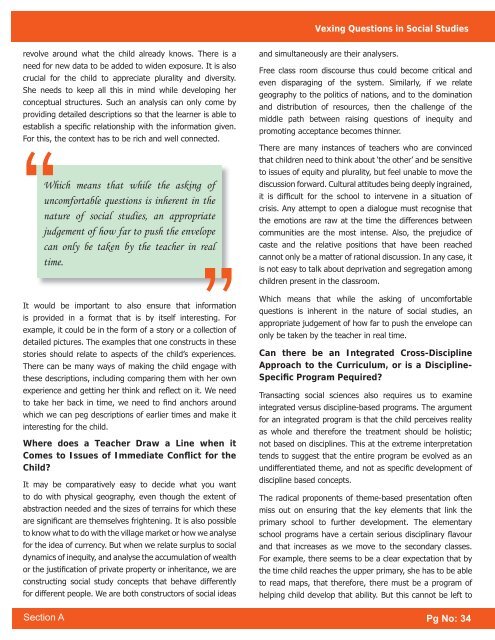Indesign Pagesnew.indd - Azim Premji Foundation
Indesign Pagesnew.indd - Azim Premji Foundation
Indesign Pagesnew.indd - Azim Premji Foundation
You also want an ePaper? Increase the reach of your titles
YUMPU automatically turns print PDFs into web optimized ePapers that Google loves.
evolve around what the child already knows. There is a<br />
need for new data to be added to widen exposure. It is also<br />
crucial for the child to appreciate plurality and diversity.<br />
She needs to keep all this in mind while developing her<br />
conceptual structures. Such an analysis can only come by<br />
providing detailed descriptions so that the learner is able to<br />
establish a specifi c relationship with the information given.<br />
For this, the context has to be rich and well connected.<br />
Which means that while the asking of<br />
uncomfortable questions is inherent in the<br />
nature of social studies, an appropriate<br />
judgement of how far to push the envelope<br />
can only be taken by the teacher in real<br />
time.<br />
It would be important to also ensure that information<br />
is provided in a format that is by itself interesting. For<br />
example, it could be in the form of a story or a collection of<br />
detailed pictures. The examples that one constructs in these<br />
stories should relate to aspects of the child’s experiences.<br />
There can be many ways of making the child engage with<br />
these descriptions, including comparing them with her own<br />
experience and getting her think and refl ect on it. We need<br />
to take her back in time, we need to fi nd anchors around<br />
which we can peg descriptions of earlier times and make it<br />
interesting for the child.<br />
Where does a Teacher Draw a Line when it<br />
Comes to Issues of Immediate Confl ict for the<br />
Child?<br />
It may be comparatively easy to decide what you want<br />
to do with physical geography, even though the extent of<br />
abstraction needed and the sizes of terrains for which these<br />
are signifi cant are themselves frightening. It is also possible<br />
to know what to do with the village market or how we analyse<br />
for the idea of currency. But when we relate surplus to social<br />
dynamics of inequity, and analyse the accumulation of wealth<br />
or the justifi cation of private property or inheritance, we are<br />
constructing social study concepts that behave differently<br />
for different people. We are both constructors of social ideas<br />
Section A<br />
Vexing Questions in Social Studies<br />
and simultaneously are their analysers.<br />
Free class room discourse thus could become critical and<br />
even disparaging of the system. Similarly, if we relate<br />
geography to the politics of nations, and to the domination<br />
and distribution of resources, then the challenge of the<br />
middle path between raising questions of inequity and<br />
promoting acceptance becomes thinner.<br />
There are many instances of teachers who are convinced<br />
that children need to think about ‘the other’ and be sensitive<br />
to issues of equity and plurality, but feel unable to move the<br />
discussion forward. Cultural attitudes being deeply ingrained,<br />
it is diffi cult for the school to intervene in a situation of<br />
crisis. Any attempt to open a dialogue must recognise that<br />
the emotions are raw at the time the differences between<br />
communities are the most intense. Also, the prejudice of<br />
caste and the relative positions that have been reached<br />
cannot only be a matter of rational discussion. In any case, it<br />
is not easy to talk about deprivation and segregation among<br />
children present in the classroom.<br />
Which means that while the asking of uncomfortable<br />
questions is inherent in the nature of social studies, an<br />
appropriate judgement of how far to push the envelope can<br />
only be taken by the teacher in real time.<br />
Can there be an Integrated Cross-Discipline<br />
Approach to the Curriculum, or is a Discipline-<br />
Specifi c Program Pequired?<br />
Transacting social sciences also requires us to examine<br />
integrated versus discipline-based programs. The argument<br />
for an integrated program is that the child perceives reality<br />
as whole and therefore the treatment should be holistic;<br />
not based on disciplines. This at the extreme interpretation<br />
tends to suggest that the entire program be evolved as an<br />
undifferentiated theme, and not as specifi c development of<br />
discipline based concepts.<br />
The radical proponents of theme-based presentation often<br />
miss out on ensuring that the key elements that link the<br />
primary school to further development. The elementary<br />
school programs have a certain serious disciplinary fl avour<br />
and that increases as we move to the secondary classes.<br />
For example, there seems to be a clear expectation that by<br />
the time child reaches the upper primary, she has to be able<br />
to read maps, that therefore, there must be a program of<br />
helping child develop that ability. But this cannot be left to<br />
Pg No: 34

















